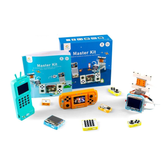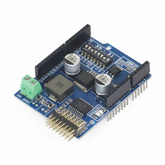-
Official Arduino Portenta Vision Shield with Ethernet Connectivity - ASX00021Official Arduino Portenta Vision Shield with Ethernet Connectivity The Official Arduino Portenta Vision Shield with Ethernet Connectivity is a powerful hardware expansion designed to bring advanced industrial features to your Arduino Portenta projects. Specifically built for the Portenta H7, this shield enables embedded computer...
- Rs. 5,199
Rs. 7,499- Rs. 5,199
- Unit price
- per
Save Rs. 2,300 -
Cytron 10Amp 7V-30V Dual Channel DC Motor Driver Shield for ArduinoCytron 10Amp 7V-30V Dual Channel DC Motor Driver Shield for Arduino The Cytron 10Amp 7V-30V Dual Channel DC Motor Driver Shield for Arduino is a powerful and versatile Cytron motor driver designed to simplify motor control in robotics and automation projects. As a 10A...
- Rs. 2,988
Rs. 4,064- Rs. 2,988
- Unit price
- per
Save Rs. 1,076 -
ELECROW eBus Adapter Shield C6 with Translucent Enclosure USR-ES1 Module without EthernetELECROW eBus Adapter Shield C6 with Translucent Enclosure USR-ES1 Module without Ethernet The eBUS Adapter Shield C6 offers an interface to a 2-wire eBUS with galvanic isolation, enabling reliable communication with eBUS-compatible heating, ventilation, or solar systems. As an enhanced version of the previous...
- Rs. 3,999
Rs. 4,999- Rs. 3,999
- Unit price
- per
Save Rs. 1,000 -
Arduino 16 channel PWM Servo Motor Shield16 channel PWM Servo Motor Shield for Arduino The 16-Channel 12-bit PWM/Servo Driver Shield is designed for development boards compatible with Arduino which will drive up to 16 servos over I2C with only 2 pins. You can use jumper wires to connect. The onboard PWM...
- Rs. 492
Rs. 649- Rs. 492
- Unit price
- per
Save Rs. 157 -
Arduino Mega 2560 R3 Sensor Shield V2.0 compatibleMega 2560 R3 Sensor Shield V2.0 compatible with Arduino The Arduino mega has many more i/o pins (54 digital pins and 16 analog pins)than a standard Arduino. This Arduino shield also has connectors specifically for some external devices like an SD card, radio communications (Bluetooth and others)....
- Rs. 149
Rs. 229- Rs. 149
- Unit price
- per
Save Rs. 80 -
Arduino 3.2in TFT LCD Display Shield3.2in TFT LCD Display Shield for Arduino The 3.2 TFT LCD display shield compatible with arduino is a powerful interface and is equipped with an SD card reader. It's powerful features allow multifunctional abilities for your projects. The TFT LCD display is also user...
- Rs. 1,179
Rs. 1,599- Rs. 1,179
- Unit price
- per
Save Rs. 420 -
Arduino 2.4inch TFT Display for Arduino UNO board compatible2.4inch TFT Display for Arduino UNO board compatible with Arduino The TFT LCD display shield is designed with a built in microSD card connection. This TFT display is big (2.4? diagonal) bright (4 white-LED backlight) and colorful (18-bit 262,000 different shades) 240×320 pixels with individual pixel control. It...
- Rs. 463
Rs. 684- Rs. 463
- Unit price
- per
Save Rs. 221 -
Cytron PS2 Shield for ArduinoCytron PS2 Shield for Arduino The Cytron PS2 Shield is a compact and reliable PS2 controller interface designed for Arduino boards, making remote control projects smoother and far more intuitive. Whether you're working with an Arduino Uno, Mega, Leonardo, or other compatible boards, this...
- Rs. 1,280
Rs. 1,949- Rs. 1,280
- Unit price
- per
Save Rs. 669 -
Cytron ESP8266 WiFi Shield for Arduino with WROOM-02 ModuleCytron ESP8266 WiFi Shield for Arduino with WROOM-02 Module The Cytron ESP8266 WiFi Shield is a beginner-friendly, plug-and-play solution that makes adding WiFi connectivity to Arduino projects incredibly easy. Powered by the reliable ESP8266 WROOM-02 module, this shield eliminates the wiring complications and level-shifting...
- Rs. 779
Rs. 1,299- Rs. 779
- Unit price
- per
Save Rs. 520 -
Cytron 8-Channel RC Servo Controller Shield – 5V 5A Regulated Power for ArduinoCytron 8-Channel RC Servo Controller Shield – 5V 5A Regulated Power for Arduino The Cytron 8-Channel RC Servo Controller Shield is designed for makers, robotics enthusiasts, and educators who need reliable, high-power servo control for Arduino projects. With its built-in 5V 5A switching regulator,...
- Rs. 1,499
Rs. 2,199- Rs. 1,499
- Unit price
- per
Save Rs. 700 -
Arduino UNO Sensor Shield Expansion board V5UNO Sensor Shield for Arduino Expansion board V5 This sensor shield for UNO board compatible with Arduino is the latest shield V5 model. This sensor shield allows you to connect to various modules like sensors, servos, relays, buttons, potentiometers and many more directly to your Arduino through...
- Rs. 83
Rs. 129- Rs. 83
- Unit price
- per
Save Rs. 46 -
Arduino UNO Prototyping ShieldUNO Prototyping Shield for Arduino UNO Prototype Shield is used in the cases where you want to build more applications without using any external Breadboard. This prototyping shield for Arduino helps in expanding the functionalities of UNO board and create extra connections for embedded...
- Rs. 77
Rs. 114- Rs. 77
- Unit price
- per
Save Rs. 37 -
Arduino CNC ShieldCNC Shield for Arduino The CNC shield for Arduino has total four slots, can drive 4 A4988 stepper motors. Each road stepper motors only need two IO ports. In other words, six IO ports can be well managed three stepper motors. The CNC Shield V3.0...
- Rs. 101
Rs. 199- Rs. 101
- Unit price
- per
Save Rs. 98 -
Cytron SHIELD-3AMOTOR 1.2A Dual Channel 7V–30V DC Motor Driver Shield for ArduinoCytron SHIELD-3AMOTOR 1.2A Dual Channel 7V–30V DC Motor Driver Shield for Arduino The Cytron SHIELD-3AMOTOR is a high-performance, dual-channel DC motor driver shield designed for Arduino users who need reliable and efficient motor control. Supporting motor voltages from 7V to 30V and delivering up...
- Rs. 1,489
Rs. 2,199- Rs. 1,489
- Unit price
- per
Save Rs. 710 -
Arduino L293D Motor Driver shieldL293D Motor Driver shield for Arduino The L293D motor shield for Arduino is designed as a full-featured motor shield that will be able to power many simple to medium-complexity projects. This motor driver shield can be used to drive up to 4 DC motors. (up to 600MA...
- Rs. 109
Rs. 149- Rs. 109
- Unit price
- per
Save Rs. 40 -
SmartElex GSM/GPRS Shield for Arduino - Quectel M66 ModuleSmartElex GSM/GPRS Shield for Arduino - Quectel M66 Module The SmartElex GSM/GPRS Shield for Arduino - Quectel M66 Module is a compact and reliable Arduino GSM GPRS shield that connects your Arduino board to a cellular GSM network. With this shield, you can easily...
- Rs. 2,129
Rs. 3,099- Rs. 2,129
- Unit price
- per
Save Rs. 970 -
Arduino Uno CC3000 Wifi ShieldThis is a shield for the CC3000 WiFi Module. The CC3000 from TI (Texas Instruments) is a self-contained wireless network processor that makes incorporating internet connectivity into your project simple. Supply Voltage: 4.5V - 12V Host Interface: SPI @ 16MHZ Throughput (TCP): ~4Mbps IEEE...
- Rs. 3,548
Rs. 4,109- Rs. 3,548
- Unit price
- per
Save Rs. 561

Best Price Guarantee

Ready Stock for Bulk Purchase

Dedicated Account Managers

5% GST Benefits for Eligible SEZ and Edu

Technical Support Available

1-Year Manufacturer Warranty
















































